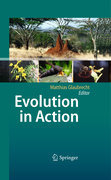
Evolution in action: case studies in adaptive radiation, speciation and the origin of biodiversity
Glaubrecht, Matthias
We have come a long way towards better understanding how new species originate, i.e. speciation, which long remained Darwin’s “mystery of mysteries.” Sincespeciation is the underlying mechanism for radiations, it is the ultimate causation for the biological diversity of life that surrounds us. Without a doubt, Charles Darwin’s contribution to our understanding of the origin of biodiversity cannot be overestimated. This book is a contribution to both the Darwin Year we celebrated in 2009 and to the Year of Biodiversity and Conservation 2010. The studies and model cases presented show the progress and dynamics of research based on Darwinian theories and sheds light on its implications in the context of current biodiversity crises. The great importance of adaptive (and non-adaptive) radiations for biodiversity is widely accepted, but our understanding of the processes and mechanisms involved is still limited and generalizations need to be based on the accumulation of more evidence from additional case studies. The studies presented in this volume are those urgently needed and focus on a variety of organisms and different aspects of radiations. The scientific results presented therein are excellent examples not only of evolution in action, but also of active research on evolutionary processes and their mostapparent outcome – biodiversity. Reveals many aspects among the wide spectrumof current approaches in evolutionary research Presents a colourfully illustrated survey of current evolutionary biology research Use of modern techniques from molecular biology, bioinformatics and systematic phylogeny Allows the reconstruction of the relationships of organisms, the course of evolution and itsunderlying causations INDICE: Part I - Approaches in Botany.- Rapid Radiations and Neoendemism in the Madagascan Biodiversity Hotspot.- Rapid Radiation in the Barley Genus Hordeum (Poaceae) During the Pleistocene in the Americas.- Studying Adaptive Radiation at the Molecular Level: A Case Study in the Macaronesian Crassulaceae-Sempervivoideae.- Key Innovations versus Key Opportunities: Identifying Causes of Rapid Radiations in Derived Ferns.- Evolution of the Mating System in the Genus Capsella (Brassicaceae).- Pollinator - Driven Speciation in Sexually Deceptive Orchids of the Genus Ophrys.- Population Genetics of Speciation and Demographic Inference under Population Subdivision: Insights from Studies on Wild Tomatoes (Solanum sect. Lycopersicon).- Genetic Diversity, Evolution and Domestication of Wheat and Barley in the Fertile Crescent.- Part II - Host- Plant Interaction .- Mechanisms of Speciation in Southeast Asian Ant-Plants of the Genus Macaranga (Euphorbicaceae) .- Speciation in Obligately Plant-Associated Crematogaster Ants: Host-Distribution rather than Adaption Towards Specific Hosts Drives the Process.- Radiation, Biological Diversity and Host-Parasite Interactions in Wildroses, Rust Fungi and Insects.- Speciation via Differential Host-Plant Use in the Tephritid Fly Tephritis conura.- Part III - Approaches in Zoology.- Solar Powered Seaslugs (Opisthobranchia, Gastropoda, Mollusca): Incorporation of Photosynthetic Units – A Key Character Enhancing Radiation?.- Are Cuticular Hydrocarbons Involved in Speciation of Fungus-Growing Termites (Isoptera: Macrotermitinae)?.- Electric Organ Discharge Divergence Promotes Ecological Speciation in Sympatrically Occurring African Weakly Electric Fish (Campylomormyrus).- Ongoing Phenotypic and Genotypic Diversification in Adaptively Radiated Freshwater Crabs from Jamaica.- The Herring Gull Complex (Larus argentatus - fuscus - cachinnans) as a Model Group for Recent Holarctic Vertebrate Radiations.- Genetic Divergence and Evolution of Reproductive Isolation in Eastern Mediterranean Water Frogs .- Inferring Multiple Corsican Limax (Pulmonata: Limacidae) Radiations: A Combined Approach Using Morphology and Molecules .- Palaeogeography or Sexual Selection – Which Factors Promoted Cretan Land Snail Radiations?.- Non-Ecological Radiations in Acoustically Communicating Grasshoppers?.- Beyond Sympatric Speciation: Radiation of Sailfin Silverside Fishes inthe Malili Lakes (Sulawesi).- The Species Flocks of the Viviparous FreshwaterGastropod Tylomelania (Mollusca: Cerithioidea: Pachychilidae) in the Ancient Lakes of Sulawesi, Indonesia – The Role of Geography, Trophic Morphology and Colour as Driving Forces in Adaptive Radiation.- Causations of a Riverine Radiation: Assessment and Evaluation of the Morphological and Genetical Differentiation in a Species Flock of Viviparous Gastropods (Cerithioidea: Pachychilidae).- The Neglected Side of the Coin: Non-Adaptive Radiations in Spring Snails (Bythinella spp.)
- ISBN: 978-3-642-12424-2
- Editorial: Springer
- Encuadernacion: Cartoné
- Páginas: 550
- Fecha Publicación: 01/07/2010
- Nº Volúmenes: 1
- Idioma: Inglés
- Inicio /
- /
